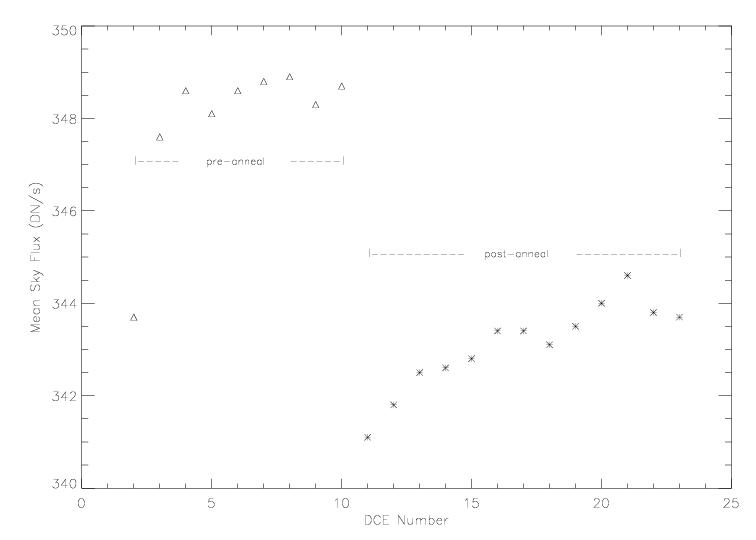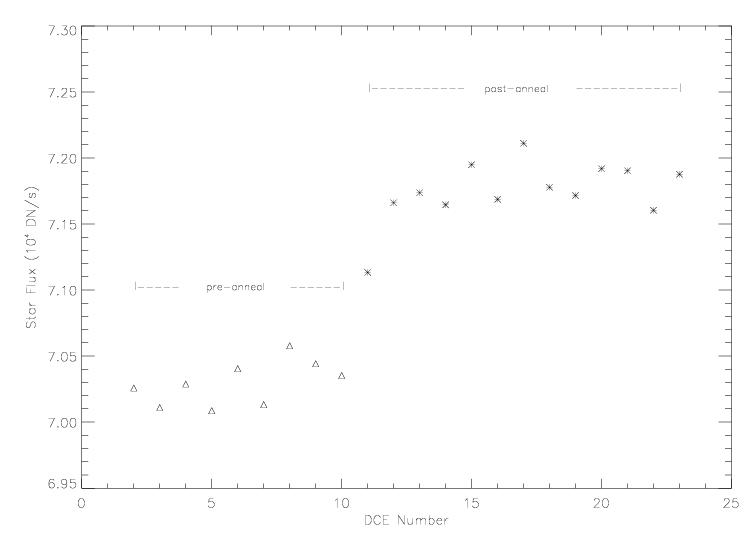
Principal:
Deputy:
Analyst:
AORKEYS:
Last Updated:
We converted the diagnostic data from the thermal anneal into temperatures and generated temperature plots. These data are compared to the temperature curves from previous anneals. These data are presented in the metatask writeup mips-2050.
We compared the 24um SUR data taken before and after the thermal anneal to look for changes in array behavior. The item of interest was the detector responsivity. The data were reduced with mips_sloper with no flags. The source and sky brightnesses were measured with the IRAF task imexamine with radius=6, buffer=5, width=5, background=yes, center=yes, iterations=1, and the sky levels were also measured using the IRAF task imstat.
Pre-anneal flux levels, MIPS-992 MIPS.1.0007525888.0000.0000.tran_ext.red.fits DCE StarFlux SkyFlux FrameMean FrameMedian 2 70258. 343.7 343.7 +/- 156.8 339.6 3 70110. 346.5 347.6 +/- 157.7 342.3 4 70288. 348.4 348.6 +/- 158.8 344. 5 70086. 348.2 348.1 +/- 157.1 343.5 6 70405. 348.1 348.6 +/- 157.3 344.6 7 70132. 347.9 348.8 +/- 157.3 344.5 8 70578. 347.9 348.9 +/- 159.5 343.8 9 70442. 348.1 348.3 +/- 157.4 344.4 10 70353. 348. 348.7 +/- 157.5 343.8 Post-anneal flux levels, MIPS-992 MIPS.1.0007525888.0004.0000.tran_ext.red.fits DCE StarFlux SkyFlux FrameMean FrameMedian 1 71133. 341.2 341.1 +/- 158.8 337.3 2 71661. 341.1 341.8 +/- 162.6 338.5 3 71737. 341. 342.5 +/- 175.9 338.6 4 71645. 341.3 342.6 +/- 162.5 339.2 5 71949. 341. 342.8 +/- 161.7 340.1 6 71687. 340.8 343.4 +/- 184.4 338.4 7 72111. 340.8 343.4 +/- 164.4 339.1 8 71778. 342.4 343.1 +/- 163.1 340.6 9 71716. 342.4 343.5 +/- 162.8 339.9 10 71919. 342.3 344. +/- 163. 340.2 11 71904. 342.2 344.6 +/- 169.7 340.4 12 71604. 342.2 343.8 +/- 163.3 340. 13 71877. 342.4 343.7 +/- 163.4 339.9The median star and sky fluxes are plotted below:


Without proper flatfielding, it is hard to place any significance on the change in star brightness. I flatfielded using the pre-flight flat and should have used the campaign H1 flat. For the sky frames, the first DCE after the bias boost is low in the pre-anneal set; all of the post-anneal DCEs come one DCE after a bias boost and so are subject to the same boost latent. Comparing the post-anneal sky brightnesses with the pre-anneal DCE 2, I see insignificant changes in the measured sky levels. As in previous campaigns, the cosmic ray exposure during these short campaigns has no measurable effect on the responsivity of the 24um array.